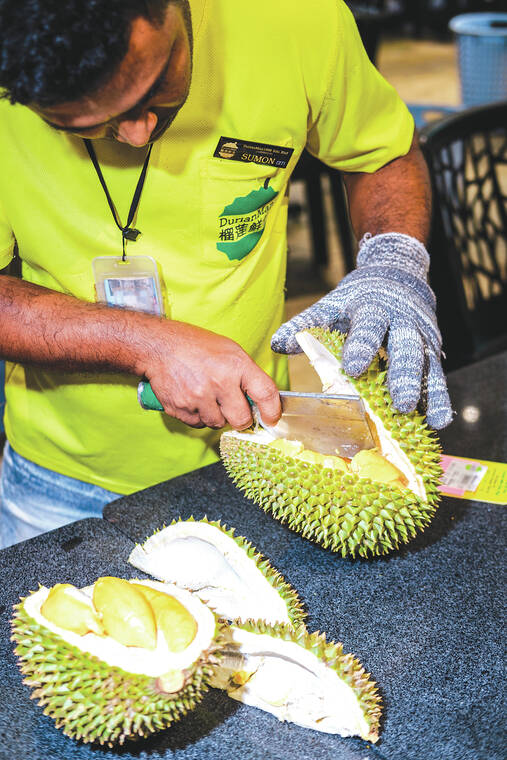China’s lust for durian is creating fortunes in Southeast Asia
RAUB, Malaysia — Before he started a company 15 years ago selling the world’s smelliest fruit, Eric Chan had a well-paying job writing code for satellites and robots. His family and friends were puzzled when he made the career change.
The fruit, durian, has long been a cherished part of local cultures in Southeast Asia, where it is grown in abundance. A single durian is typically the size of a rugby ball and can emit an odor so powerful that it is banned from most hotels. When Chan began his startup in his native Malaysia, durians were cheap and often sold from the back of trucks.
Then China acquired a taste for durian in a very big way.
Last year, the value of durian exports from Southeast Asia to China was $6.7 billion, a twelvefold increase from $550 million in 2017. China buys virtually all of the world’s exported durians, according to United Nations data. The biggest exporting country by far is Thailand; Malaysia and Vietnam are the other top sellers.
Today, businesses are expanding rapidly — one Thai company is planning an initial public offering this year — and some durian farmers have become millionaires. Chan is one of them. Seven years ago, he sold a controlling share of his company, which specializes in producing durian paste for cookies, ice cream and even pizza, for the equivalent of $4.5 million, nearly 50 times his initial investment.
“Everybody has been making good money,” Chan said of the once-poor durian farmers in Raub, a small city 90 minutes from Kuala Lumpur, the Malaysian capital. “They rebuilt their houses from wood to brick. And they can afford to send their children overseas for university.”
Farmers in Southeast Asian durian orchards say they can’t recall anything like the China craze.
The surge in durian exports is a measure of the power of Chinese consumers in the global economy, even though, by other measures, the mainland economy is struggling. When an increasingly wealthy country of 1.4 billion people gets a taste for something, entire regions of Asia are reshaped to meet the demand.
In Vietnam, state news media reported last month that farmers were cutting down coffee plants to make room for durian. The acreage of durian orchards in Thailand has doubled over the past decade. In Malaysia, jungles in the hills outside Raub are being razed and terraced to make way for plantations that will cater to China’s lust for the fruit.
“I think durian will be the new economic boom for Malaysia,” said Mohamad Sabu, the country’s minister of agriculture.
With so much money at stake, the race to plant more trees has spawned tensions. Land disputes have broken out over durian orchards. Some roadside orchards are surrounded by coils of razor wire. “Thieves Will Be Prosecuted,” a sign outside an orchard in Raub said, with a drawing of handcuffs.
China is not only a buyer. Chinese investment has flowed into Thailand’s durian packing and logistics business. Already, Chinese interests control around 70% of the durian wholesale and logistics business, according to Aat Pisanwanich, a Thai expert in international trade. Thailand’s own wholesale durian companies could “disappear in the near future,” he said at a news conference in May.
Durian is to fruit what truffles are to mushrooms: Pound for pound, the fruit has become one of the most expensive on the planet. Depending on the variety, a single durian can sell for $10 to hundreds of dollars.
But Chinese demand, which has pushed up prices fifteenfold over the past decade, has frustrated Southeast Asian consumers, who see durians morphing from a plentiful fruit growing in the wild and in village orchards to a luxury commodity earmarked for export.
Countries are exporting a fruit that is an integral part of their identities and cultures, especially in Malaysia, where it is a unifying national icon among its many ethnic groups. “God gave us a desire for durian,” said Hishamuddin Rais, a Malaysian film director and political activist.
The China surge is reshaping the durian supply chain. It’s relatively easy to deliver the fruit in the back of a truck to regional destinations like Kuala Lumpur, Singapore or Bangkok. But shipping it to Guangzhou, Beijing and beyond, especially when the fruit is ripe and most flavorful, can be perilous. The fruit’s potent smell can resemble a gas leak.
Malaysia has tried to solve the transport problem by freezing the fruit before shipping. One of the pioneers of the process was Anna Teo, a former flight attendant who noticed on her travels that durian was not available overseas.
She quit her airline job and experimented with cryogenic freezing techniques in a rented warehouse, hauling her children to durian farms on weekends. She found that freezing not only mitigated the fruit’s odor but also prolonged its shelf life.
Today, in a suburb of Kuala Lumpur, Teo oversees more than 200 employees at the company she founded, Hernan, which exports frozen durian as well as mochi and other durian products.
Thailand, by contrast, has been shipping fresh durian in refrigerated containers for many years. The Thai durian industry is centered in Chanthaburi province, near the border with Cambodia. During peak harvest season, in May and June, heaping piles of durian are everywhere.
Around 1,000 shipping containers of durian leave packinghouses throughout Chanthaburi every day, creating durian traffic jams that rival manic Bangkok intersections. Some containers are loaded onto what the Thai media calls the Durian Train.
Across Chanthaburi, the signs of durian wealth are everywhere: modern houses and new hospitals. A shopping mall, inaugurated two years ago, hosted a car show in April.
“When you’re from another province and you arrive here, you come to realize that durian farmers are very, very rich,” said Abhisit Meechai, a car dealer who on a recent afternoon was selling MG vehicles, the venerable British brand owned by SAIC Motor, a Chinese automaker.
“Never judge a book by its cover,” Abhisit said of his customers who are durian farmers. “They come with dirty clothes and dirty hands. But they pay for their cars with cash.”



